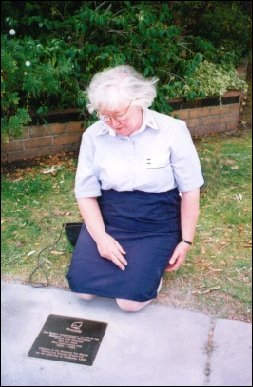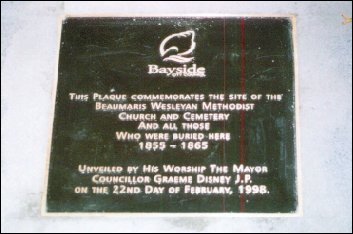The Beaumaris Cemetery

Shirley Joy by the bronze memorial plaque, which acknowledges the site of the Beaumaris Cemetery.
How could a cemetery disappear? The search for the location of the Beaumaris cemetery began with Shirley Joy’s desire to find the grave of her pioneer grandmother, Ann Addicott who came to the colony of Port Phillip in 1841 with her husband John and two children. Death records showed that she was buried in the Beaumaris Cemetery on January 18, 1863 but where was it?
Initial inquiries failed to identify the location of the cemetery so Shirley set out searching local church records, local family histories held in the municipal library and records held centrally by the Uniting Church in Australia. It was at this last location that the hand written account of a gift from Stephen Charman to the Methodist Church in 1855 provided a crucial clue. Further inquiries at the Office of the Registrar General and the Land Titles Office finally allowed identification of the site of the Wesleyan church and cemetery on what is now described as the western corner of Balcombe Road and Bickford Court. It is a location where seven modern brick homes now stand.
The church building on the site was sold in 1893 and moved to Langwarrin. The land was used then to graze cattle and Perry Bros used the site as part of their winter headquarters for their circus animals. In 1954 an application was made to the Moorabbin Council by a surveyor for a permit, on behalf of the Methodist Church Trustees, to subdivide the land. Shirley Joy writes that "Cr Everest Le Page argued that it was not appropriate to sub-divide the site as he believed there were still bodies buried there." Despite Le Page’s objections, approval was given and the seven lots of land were subsequently sold for housing development.
Shirley Joy’s inquiries at the Cheltenham Cemetery and the Department of Health and Community Services indicated that bodies buried at Beaumaris in the period 1855 to 1865 had not been moved. So she proceeded with her resolution that "their existence should never be denied nor ignored". She confirmed the burials of 28 people and subsequently verified an additional five. Undaunted she continued with the assistance of Datapoint, Family History Researchers and found a further 93 burials.
On February 22, 1998 Shirley Joy’s persistent efforts to have the pioneers buried at Beaumaris recognised came to fruition. The Mayor of Bayside, Cr Graeme Disney, unveiled a bronze plaque which commemorates the site of the "Beaumaris Wesleyan Methodist Church and Cemetery and all those who were buried here 1855-1865." The plaque is set into the footpath at the corner of Balcombe Road and Bickford Court, Beaumaris.

Bronze memorial plaque which acknowledges the site of the Beaumaris Cemetery.
The names of the people buried there (listed below) include families prominent in the history of Kingston; they include Bruton, Charman, Goldstone, Le Page, Meeres, Moysey; Penny, Rose, Rout, Ruse, Tuck, and Whorrall. Shirley Joy in her book The Search for the Beaumaris Cemetery gives additional details of interest to local and family historians. Information on the age, cause of death, and parents of the deceased is also given together with details from some inquests into cause of death.
Addicott, Anne
Allen, Albert Henry
Allen, Elizabeth Ann
Allen, Frederick William
Allen, Oliver Castle
Arbour, Elizabeth
Baker, Elizabeth
Baker, Mary Ann
Baker, Sarah Ann
Barber, Frances
Barker, John
Barnett Mary Jane
Beazley, Ann
Blencowe, Annie Euphemia
Bolen, Samuel
Brooks, James Walter Wright
Brown, Mary Ann
Bruton, Eleanor Margaret
Bruton, George Edward
Cameron, Edwin
Campbell, Julia Catherine
Cartmell, Sarah Caroline
Castle, John George
Castle, Miriam
Chandler, William
Charman, Elizabeth Lucy
Charman, John Arthur
Curwen, Fanny
Dare, Bessie
Dawborn, Arthur Rigg
Dawbourn, Mary Ann
Dowton, Arthur
Dowton, John
Dunkley, Arthur
Edmeades, Charles Henry
Edwards, Jessie
Forrest, Janet
Francis, Matilda Collins
Garton Elizabeth
Goldstone, Amy Frances
Gomm (Infant)
Gomm, George Thomas
Gott, Sarah
Gouge, Elizabeth
Hall, Robert
Hall, Samuel
Hall, William
Headley, Emily
Headley, Emily
Hilliar, Caroline
Hilliar, Henry Alfred
Hitchen, William
Hodgson, Michael
Holdsworth, James
Hughes, Sarah
Hyder, Thomas
Irvine, Archibald
Jewry, Emily
Lame, Tommy
Lay, Arthur
Lay, William
Le Lievre, John
Le Page, John
Le Page, Alfred Nicholas
Le Page, Elizabeth
Le Page, Walter
Le Page, William Alfred Addy
Mallinson, Elizabeth
Martin, William
Mason, Mary Roasa
Mcbean, George
Mccallum, Mary
Mckelvey, Isabella
Mckittrick, Elizabeth Alice
Meaker, Fredrick
Meeres, Augustus
Miller, Eliza Jane
Miler, Sarah
Miller, William
Moore, Elizabeth
Morris, Henry William Booty
Morris, (Unnamed Male)
Moysey, Sarah Jane
O’brien, Michael
Organ, James
Penny, John William
Perry, Bernard
Preston, Frances Mary
Preston, Frederick
Price, John
Richards, John Egerton
Ring, Julia
Rooke, William
Rose, William John
Rossiter, Job
Rout, Phillis
Ruse, Edward
Scott, James
Setter, Martha
Shaw, Mary
Shaw, Mary
Simpson, George
Smith, Henry John
Spurling, Elizabeth Jane
Tait, James
Thatcher, Elizabeth
Thatcher, Jane
Thatcher, Louise
Thomas, Thomas James
Trail, Annie
Tuck, Mary
Tuck, Robert
Tuck, Stephen Henry
Tyers, Mary
Walker, Charlotte
Walker, William
Watson, Eliza
Watson, James
Whorrall, Charles
Whorrall, Henrietta Wilhelmina
Wilkinson, Emelia Caroline
Wiltshire, Joseph Allen
Yates, Richard
